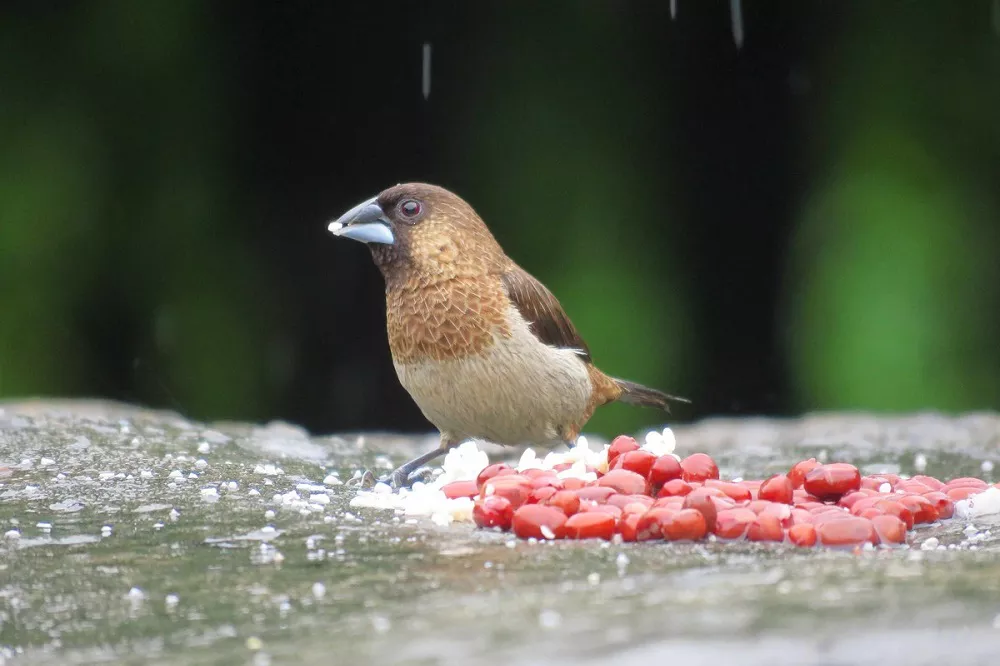The Scaly-Breasted Munia (Lonchura punctulata), also known as the Nutmeg Mannikin or Spice Finch, is a small passerine bird renowned for its striking plumage and delightful presence. Native to Southeast Asia and parts of South Asia, this avian species captivates bird enthusiasts with its distinct appearance and charming behavior. In this article, we will explore the physical characteristics and notable features that define the Scaly-Breasted Munia.
Physical Appearance
The Scaly-Breasted Munia boasts a combination of subtle colors and intricate patterns, making it an aesthetically pleasing bird to behold. Let’s delve into its distinct physical characteristics:
Size and Shape:
The Scaly-Breasted Munia is a small bird, typically measuring around 4.3 inches (11 centimeters) in length. It has a compact and plump body with a rounded head, short neck, and a short, slightly forked tail. The average weight of an adult Scaly-breasted Munia ranges from 10 to 14 grams.
Plumage and Coloration:
The Scaly-breasted Munia exhibits sexual dimorphism, meaning males and females have distinct differences in their appearance. The male’s plumage is more vibrant and colorful compared to the female.
Male Scaly-breasted Munia: The male bird has a striking black head with a glossy blue sheen that extends down to its throat and upper breast. Its back and wings are brownish-black, adorned with fine white spots that resemble scales, giving the bird its name. The underparts of the male’s body are a warm chestnut color, transitioning into a pale yellow on the lower belly. The tail is black and short, with white outer feathers that are noticeable during flight.
Female Scaly-breasted Munia: The female lacks the flashy colors of the male and has a more subdued appearance. Her head and upperparts are olive-brown, while the underparts are pale grayish-brown. The female also possesses the characteristic scale-like markings on her back and wings, but they are less prominent compared to the male. Like the male, she has a short black tail with white outer feathers.
Juvenile Scaly-breasted Munia: Juvenile birds resemble the females but have a duller and less defined appearance. They lack the scales on their wings and exhibit more uniform coloration. Their plumage gradually becomes more distinct as they mature.
Eyes, Bill, and Legs
The Scaly-breasted Munia has small, dark eyes that are set against its black head. The bill is short, stubby, and conical in shape, adapted for cracking seeds. It is black in color. The legs are relatively short and pale brown, enabling the bird to perch on grasses and low branches with ease.
Voice
The Scaly-breasted Munia has a pleasant song consisting of melodious chirps and trills. Males often sing to attract mates or establish territories, producing a series of musical notes. Their calls are high-pitched and soft.
Habitat and Range
The Scaly-Breasted Munia is native to Southeast Asia, including countries such as India, Bangladesh, Myanmar, Thailand, Vietnam, Indonesia, and the Philippines. It thrives in a variety of habitats, including grasslands, rice fields, scrublands, open woodlands, and agricultural areas. These adaptable birds are often found in flocks, actively foraging on the ground for seeds and small insects.
Behavior and Diet
Scaly-breasted Munias are social birds that form large flocks outside of the breeding season. They forage on the ground or in vegetation, feeding primarily on grass seeds, rice grains, small fruits, insects, and nectar. These birds are known to visit rice fields, where they play a beneficial role by consuming insect pests.
During courtship displays, the male Scaly-breasted Munia performs aerial acrobatics, flying in undulating patterns while singing. Once pair bonds are formed, both the male and female participate in constructing a well-organized nest made of grass and other plant materials.
Conservation Status
The Scaly-Breasted Munia is classified as a species of Least Concern by the International Union for Conservation of Nature (IUCN). However, habitat loss due to agricultural expansion and urbanization poses potential threats to their populations. Conservation efforts focus on preserving their natural habitats and raising awareness about their ecological significance.
In conclusion, the Scaly-breasted Munia is a charming and colorful bird characterized by its distinctive scale-like markings on the wings and back. With its melodious song and adaptability, this species adds beauty and vitality to the diverse avian fauna of South and Southeast Asia.


 Facebook
Facebook  Instagram
Instagram  Youtube
Youtube 